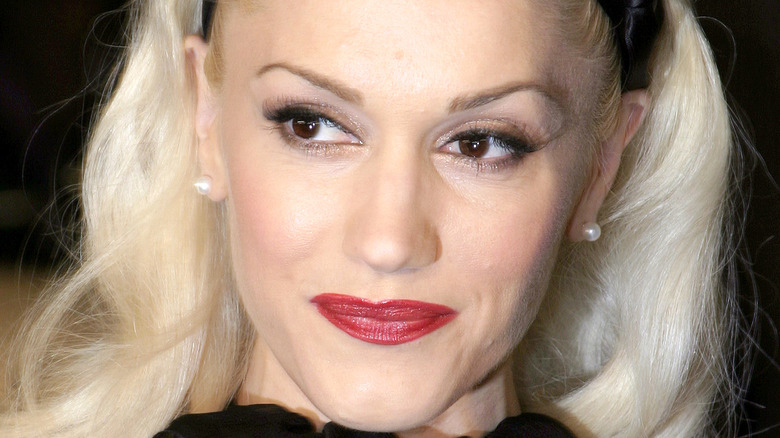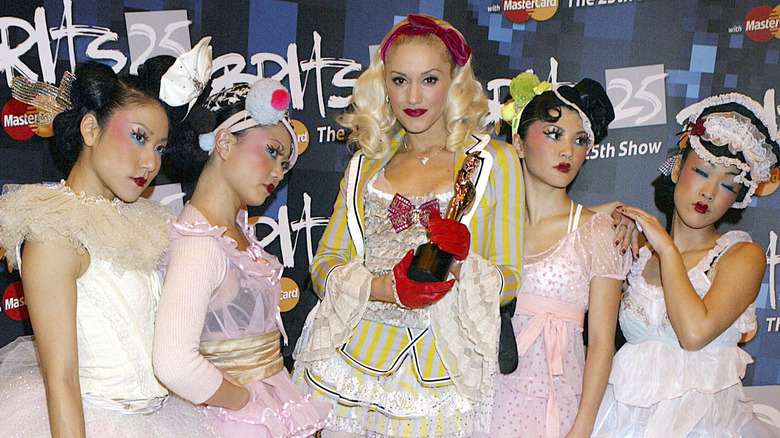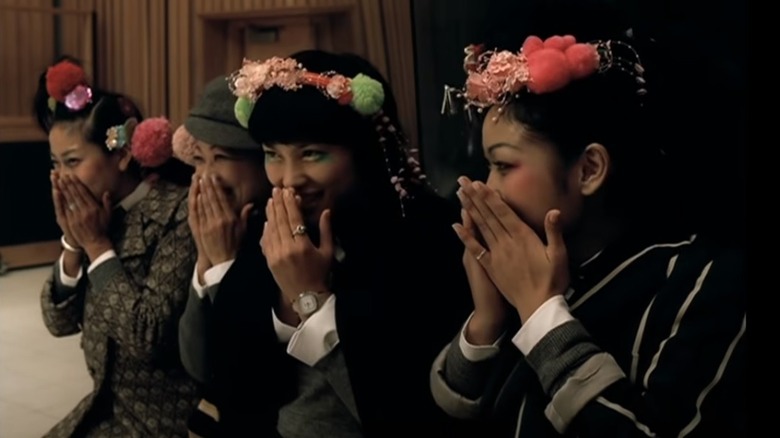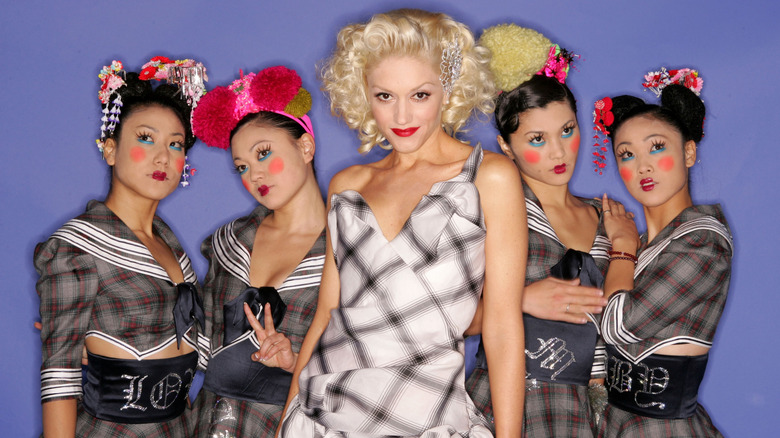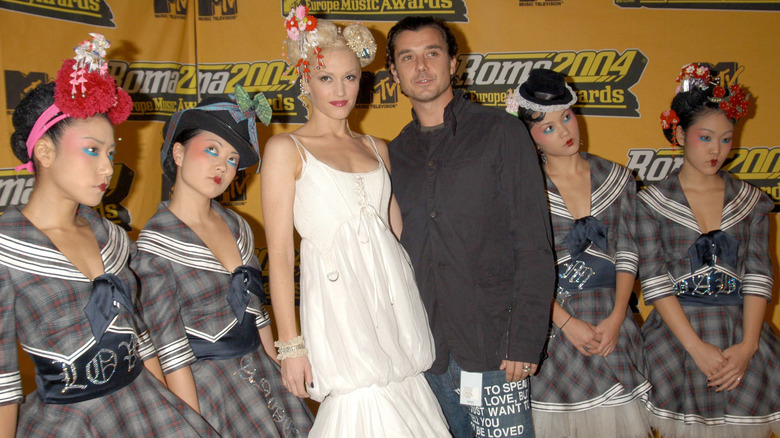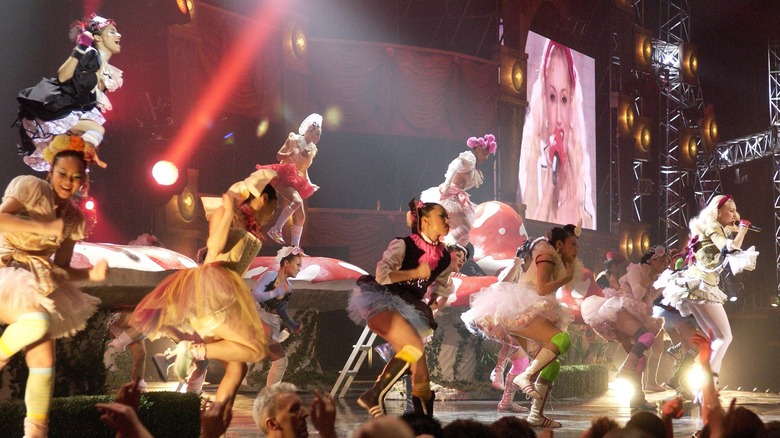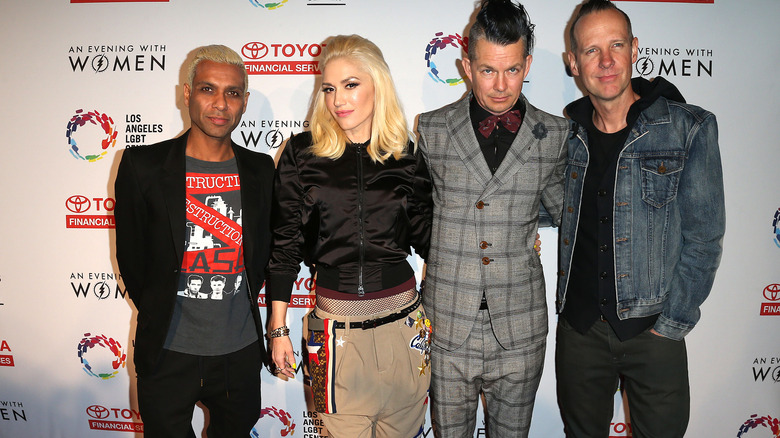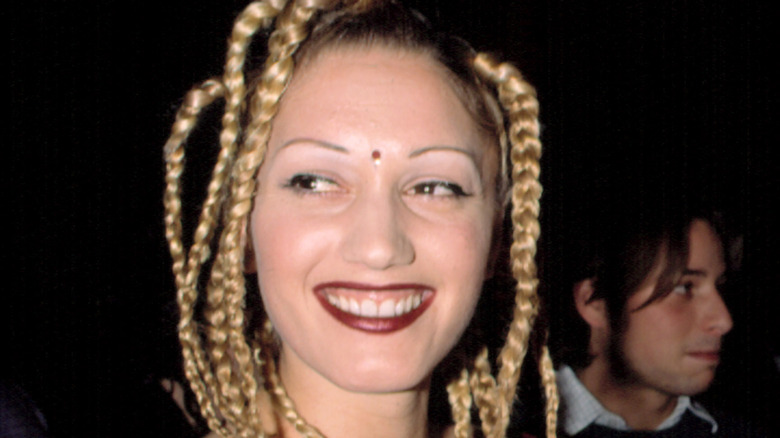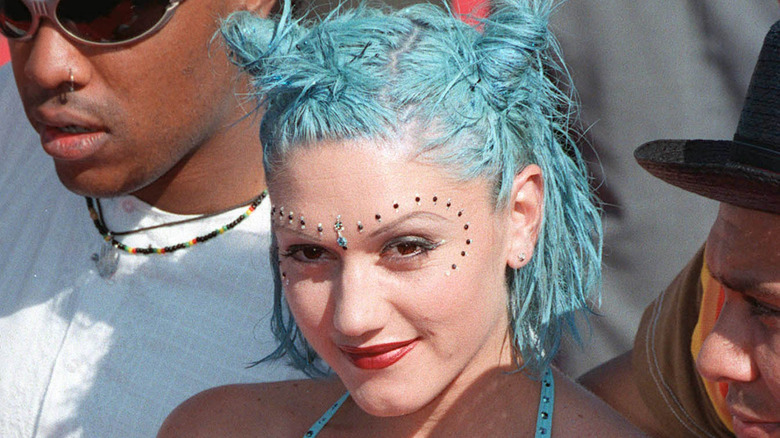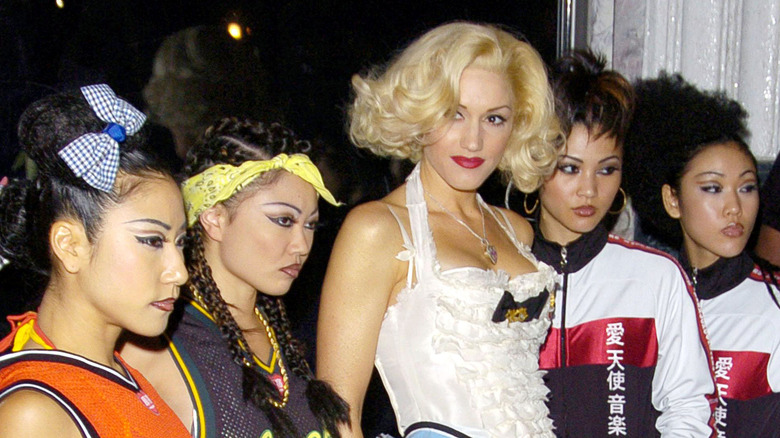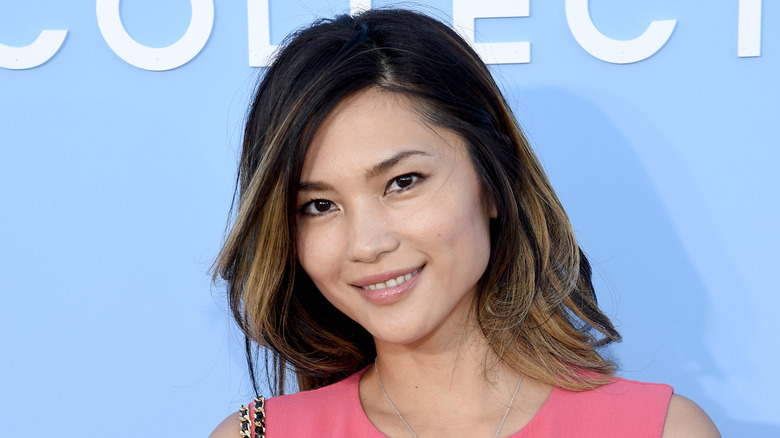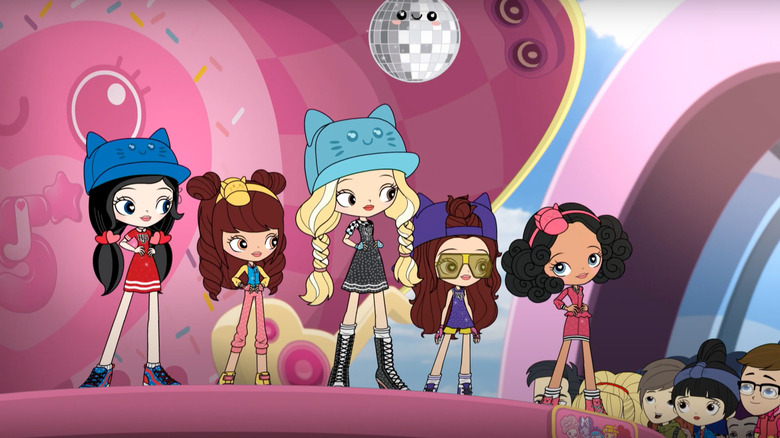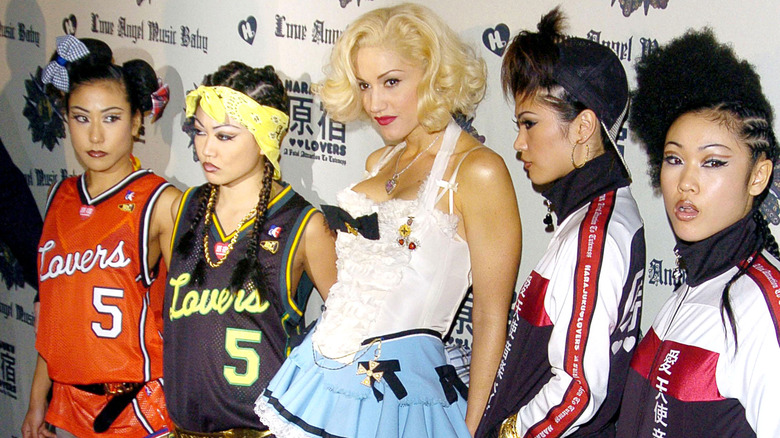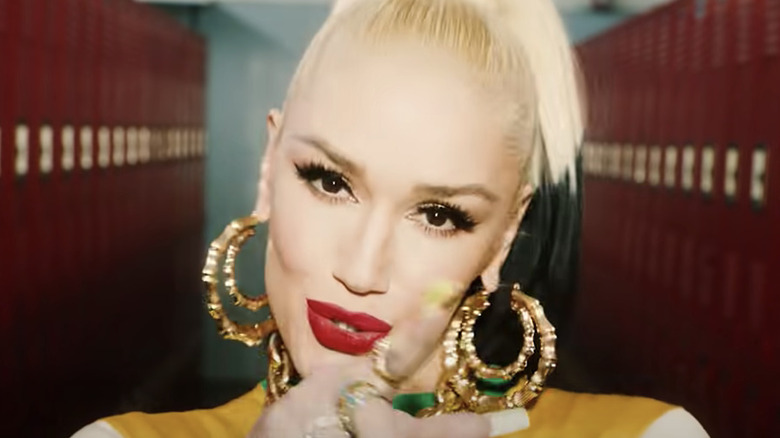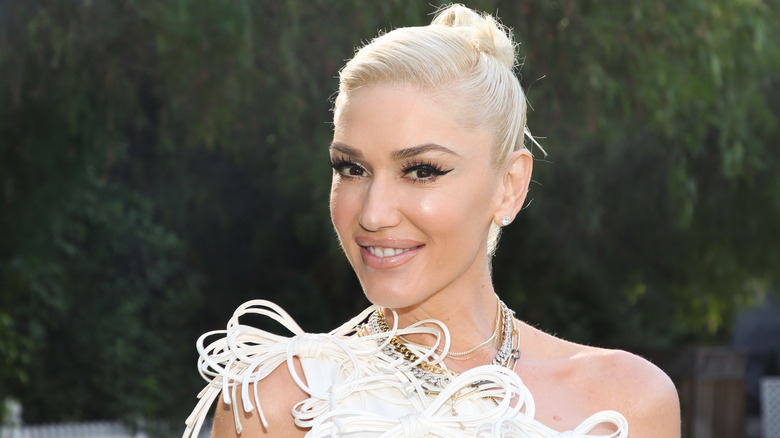A Complete Timeline Of Gwen Stefani's Harajuku Girls Controversy
In 2004, Gwen Stefani took the leap from being the frontwoman of ska band No Doubt to the centre stage of a solo career. In conjuring up her new pop persona, she entered this new spotlight with four young Japanese dancers in tow who would go by Love (Maya Chino), Angel (Jennifer Kita), Music (Rino Nakasone), and Baby (Mayuko Kitayama) — otherwise known as the Harajuku Girls.
In adopting four seemingly silent women of another culture as her backups, Stefani faced a great deal of criticism which continues to this day. While the young women were initially cast to simply be dancers for Stefani's solo project, they ended up becoming something far greater, including providing the inspiration for Stefani's ever expanding fashion and fragrance empires L.A.M.B (an acronym built from the four young women's nickname) and Harajuku Lovers respectively, with Newsweek reporting that L.A.M.B revenue was topping $100 million by 2008.
As Stefani continued to hustle that commercial success, she also continued to churn out more music as a solo performer and with No Doubt. All the while, the Harajuku Girls — and criticism — were never far behind. But where did the backlash start? And how and why are the Harajuku Girls even a thing? This is the complete timeline of the Harajuku Girls controversy, so you know the full story.
The Harajuku Girls are introduced as 'imaginary people'
Prior to the release of "What You Waiting For?" — the first single from her debut album "Love. Angel. Music. Baby." — Gwen Stefani was on the promo trail hyping up the high fashion hyperpop of her first solo project as a musician. But she wasn't alone. The star was accompanied by four stony-faced and silent Japanese girls dressed in extremely stylish modifications of a school uniform. It was odd, to say the least. And Stefani played up to the gimmick by creating a fantasy persona regarding their identity, and why these girls were accompanying the newly solo star whilst seemingly doing nothing.
On British talk show "The Jonathan Ross Show," Stefani coyly referred to the four women — shown cooly hanging out in the backstage green room — as being "kind of here, kind of not. They're kind of in my head. They're kind of my inspiration." When questioned whether she meant that the four were "imaginary people," Stefani responded, "I don't know. I thought about them and they appeared one day." Similarly, Stefani briefly played up the supposedly abstract nature of the Harajuku Girls existence during an interview with MTV aired around the same time. Gesturing to the ladies — who acted as though they were bored out of their minds — she asked someone off-camera, "Is this really real? Do you see them?!" And the answer was an uncomfortable yes. Everyone did. But for a while, nobody had too much to say in public about it.
Gwen Stefani's first single took the Girls down the rabbit hole
When Gwen Stefani's debut solo single "What You Waiting For?" was released, it was well-received by critics and listeners alike, with Pitchfork calling it, "one of the best electro songs" of 2004. The lyrics reference Stefani's writer's block and drop references to how excited the star was to "go back and do Japan," with the song's break exclaiming, "you Harajuku Girls, damn you got some wicked style."
The "Alice in Wonderland" inspired music video for the track was just as much of a hit and took the Harajuku Girls out of the lyrics and onto the screen. In the extended version of the video, Stefani is shown struggling to write a hit song. Luckily, she happens upon a mysterious phone number promising a cure for writer's block, and when Stefani calls it she's transported to a Wonderland trip of inspiration.
The Harajuku Girls show up as various characters, such as a twerking white rabbit, until Stefani is back in the studio. Suitably hopped up on her own genius, she performs for the Harajuku Girls who sit in front of her in school uniform, giggling behind their hands. Over the course of the next year, five more singles were released from the album — all of which are accompanied by music videos which predominantly feature the Harajuku Girls.
Why Gwen Stefani wanted the Harajuku Girls to 'follow her everywhere'
In an in-depth profile for Rolling Stone, Gwen Stefani revealed that she originally intended to dedicate only one song which paid tribute to the "crazy personal style" of the fashion radicals within Tokyo's Harajuku district, which she first visited in 1996. But after she dropped a reference to them in "What You Waiting For?," Stefani said she was inspired to have the Harajuku Girls "follow her everywhere" and "stand behind her and look cute," as the magazine put it.
As a result, the Harajuku Girls accompanied Stefani throughout the promotional trail, including the 2005 Harajuku Lovers tour, and there are nods to them on three songs from "Love. Angel. Music. Baby." As stated in the profile, the Harajuku Girls are professional dancers first and foremost — however, the presence of these Japanese women was so prominent within Stefani's solo project that she joked to the magazine, "I was thinking about calling the album 'Stolen Goods'. Or 'It Was Yours and Now It's Mine.'" A statement which prompted a mighty yikes from certain corners of the internet.
Gwen Stefani faced backlash
The most damning criticisms regarding Gwen Stefani's Harajuku Girls controversy arrived less than a year after the release of "Love. Angel. Music. Baby." Mihi Ahn wrote a scathing editorial for Salon suggesting that Stefani's appropriation of Harajuku subculture amounts to little more than a form of "modern-day geisha," and said of Stefani, "she's swallowed a subversive youth culture in Japan and barfed up another image of submissive giggling Asian women." Meanwhile, comedian Margaret Cho took to her website to blast Stefani for appropriating Asian culture at a time when Asian-Americans like herself continue to struggle with "a feeling of invisibility," and compared the "Japanese schoolgirl uniform" to being "kind of like blackface."
Responding to Cho's words, Stefani told Entertainment Weekly (via The Mary Sue) that the comic "didn't do her research" and called the criticism "embarrassing." The singer explained, "The truth is that I basically was saying how great that culture is ... The Harajuku Girls is an art project. It's fun!"
Not long afterwards, a movement protesting Stefani's use of the Harajuku Girls erupted online mostly focused around a blog titled "Free the Gwenihana Four." The blog purported to exist "in support of the four 'Harajuku Girls' serving an unspecified term in the custody of Gwen Stefani." Though it never amounted to much more than some (eventually blocked) merch items in support of the movement and the sharing of key resources in criticizing Stefani, the protest still garnered interest online and made some uncomfortable statements about a star seemingly at the peak of her popularity.
The Harajuku Lovers Tour brought more controversy
Sidestepping the backlash, Gwen Stefani took the Harajuku Girls on the road for the Harajuku Lovers Tour, and it received mixed reviews from critics who were either left dazzled or deflated by the show's focus on "eye candy" and "more style than substance," as the Winnipeg Sun described it.
In a recap of the show, The New York Times recounted the singer showing up "onstage amid video images of the Harajuku district of designer stores in Japan," while the Harajuku Girls are described as providing backing throughout. Describing the four women as "dancing Geisha girls," the Edmonton Sun review celebrated the choreographed elements as being "a show-stopper" and gushed at the appeal of "watching four beautiful women writhing about dressed as Japanese schoolgirls gone wild" — a statement which weirdly parallels with Mini Ahn's suggestion for Salon that the Harajuku Girls "silently vogue in the background like living props" for Stefani.
A Live Daily review from the San Jose show described the audience as being unimpressed by the spectacle and "yawning four songs into the set," while the Toronto Sun concluded that Stefani's performance was "lightweight" even whilst "surrounded by four Japanese girl dancers." The tour would officially close the curtains on the "Love. Angel. Music. Baby." era of Stefani's solo career, and the Harajuku Girls — and the criticism which came with them — were put on hiatus. But only temporarily.
No Doubt's return in 2012 was not entirely hella good
After taking time out from music to start a family with then-husband Gavin Rossdale, Gwen Stefani returned to music with No Doubt. In 2012, the band released "Settle Down," their first single from the album "Push and Shove." The music video tips its cap to No Doubt's musical legacy and Stefani's solo career... and includes cameos by the Harajuku Girls. "Even eight years after she dropped her first solo album, 'Love. Angel. Music. Baby.,'" wrote MTV, "Stefani hasn't put her Harajuku girls on the unemployment line."
More controversy bubbled up when they dropped the music video for the album's second single, "Something Hot." As noted in Spin, the video featured "a variety of Native American imagery: a teepee, smoke signals, traditional clothing including feathers and headresses." Rolling Stone reported that the "stereotypical imagery" caused complaints "with threads such as 'Appropriating Native American culture' appearing in their fan forums."
The band pulled the video almost immediately after release and issued an apology on their website (via Entertainment Weekly) which stated that though they "consulted" with Native American friends and experts about the video, the offence they caused was "of great concern." They wrote, "As a multi-racial band our foundation is built upon both diversity and consideration for other cultures. Our intention with our new video was never to offend, hurt or trivialize Native American people, their culture or their history."
A deeper focus on Gwen Stefani's past controversies
Following the "Something Hot" episode, a dialogue broke out online demanding a closer inspection of Gwen Stefani's history for fashion and performance choices which people deemed to be culturally insensitive. In an interview with the performer, Vogue referenced "the misguided Madonna-like cultural appropriation" of the Harajuku Girls and noted that the recurring issue "makes one wonder why this one area of tone-deafness prevails in someone otherwise known for being so spot on in her image-making." Stefani didn't address the controversy with the publication during the interview.
Meanwhile, Rookie Mag tackled the issue head on. In a general conversation piece about cultural appropriation titled "Something Borrowed," a selection of the youth website's contributors discussed Stefani's proclivity for "bindi wearing" and adopting "chola style" early on in her career. They also touched upon her use of the Harajuku Girls "as stereotype-affirming puppets to make money, branding an existing movement kind of like she discovered it." Jamia Wilson suggested in the piece that "Stefani's case is an offshoot" of "cultural thievery," wherein a person's privilege protects them from the experiences of the marginalised person whose culture they adopt. She said, "Gwen can play with a bindi all she wants, but she won't be judged, taunted, hated, or unsafe in certain places for wearing one, because she exists in a body that aligns with the dominant paradigm."
Gwen Stefani's 2014 releases stirred up criticism
Gwen Stefani released her second solo album "The Great Escape" ten years after her first, and clearly the cultural landscape had changed a fair bit since 2004. Stefani's solo followup was hindered by critics who continued to question the star's use of the Harajuku Girls within this era of her solo project. In October 2014, Time published a damning appraisal of Stefani's solo career on the day that "Baby Don't Lie" dropped. In reference to Stefani's appropriation of Japanese culture and the Harajuku Girls, the publication stated, "[B]efore we embrace Stefani as a comeback queen, we should pause to remember that she perpetuated some extremely racist stereotypes." The outlet suggested Stefani issue an apology for such things.
Vice quickly followed suit, delivering a 10-year retrospective reckoning of "Love. Angel. Music. Baby." which called the album a "racist pop Frankenstein" just a month before the release of her new single "The Sweet Escape." Though the review celebrated the "new wave nostalgia, pop hits, and pure, irresistible camp" of Stefani's debut solo joint, it did so whilst acknowledging that the album's "glaring problems" — such as "Stefani's fetishistic obsession with street girls from the Harajuku district" — continue to hold the album back. "Stefani can play miffed high schoolers, as she does in the 'Hollaback Girl' video," the review muses, "but she can't slip into Japanese or Latina culture like another music video costume."
Gwen Stefani tried to shut down the critics
After almost ten years of criticism, Gwen Stefani finally touched on the controversy regarding her connection to the Harajuku Girls in an interview with Time. When asked, Stefani responded that she didn't regret the Harajuku Girls and that they were intended as "a pure compliment" of the culture. "You can't be a fan of somebody else? Of another culture? Of course you can," she said. "It's a beautiful thing in the world, how our cultures come together. I don't feel like I did anything but share that love."
The performer added that the girls "were dancers that were cast, but they became real," and that all four of them "became best friends" during the job. "One girl was a Japanese girl that grew up in L.A. and she got to hang around with three different Japanese girls that were from different places in Japan and had different backgrounds," Stefani said. Clearly, the response wasn't enough to satiate the criticism, as it wouldn't be the last time the artist would be prompted to speak out on the subject.
A Harajuku Girl opened up about the gig
By 2015, everyone knew that the Harajuku Girls were a silent component of Gwen Stefani's solo project. However, one member of the Harajuku Girls broke her silence to defend Stefani and her use of Japanese culture within her persona and performances. For an interview with Tokyo Weekender, Rino Nakasone (a.k.a. "Music") was asked about her impressive dance career — which included working with the likes of Rihanna, Janet Jackson and Britney Spears — and about how she felt about criticism regarding the Harajuku Girls and Stefani's recent defence of it.
"I heard about the criticism but it didn't bother me as I knew Gwen's intention," Nakasone said, "She just really appreciates Japan ... It was like an American version of how they saw Harajuku Girls — I thought it was genius. A lot of musicians are using Japanese cultural elements in their videos these days; Gwen was like a trailblazer in that sense." And clearly, Stefani was already plotting to blaze another trail in plotting the next phase of the Harajuku Girls: Their own TV show.
Harajuku Girls, the cartoon
In 2015, the first season of Gwen Stefani's animated TV show "Kuu Kuu Harajuku" premiered on Australian television before arriving on US screens a year later. The Nickelodeon show followed Love, Angel, Music, Baby, and G in the journey of their band HJ5, and while the aesthetic of the girls continued to play on Harajuku street style, it was blasted for not depicting the Harajuku Girls as Asian. In a piece asking whether the show really has "zero Japanese characters in it," KQED wrote, "It seems Stefani (or network executives) thought the best way to deal with the overt cultural appropriation was simply 'let's not have them be Asian anymore.'"
Pop Crush similarly lamented the framing of Japanese culture within a Western lens and called "Kuu Kuu Harajuku" a "whitewashed 'kawaii' fairy tale." The article asserted that it "is not Japan, but a culturally-empty, messily regurgitated Westernization of it." Regardless, the show proved popular enough to air for three seasons, and the criticism did little to dampen Stefani's continued use of the Harajuku Girls.
Gwen Stefani reframed the 'imaginary people' angle
For the 15 year anniversary of "Love. Angel. Music. Baby.," Gwen Stefani provided an insightful track-by-track retrospective to Billboard wherein she provided nostalgic anecdotes about the songs and additional details about how or why they were written. While talking about "Harajuku Girls," the seventh track on the song's album, Stefani once again acknowledged the controversy and gave some extra information about where the "concept" for the girls came from.
Describing the opportunity to do "a dance record" as being "a fantasy" that she "thought could never happen," she told Billboard that the Harajuku Girls were an extension of this fantasy. "It was like, you're not even real, you're a dream," she said. "It wasn't like, 'You're not real because you're Asian.' Are you kidding me? That would be horrifying!' Stefani also shared how her first trip to Japan made her feel like she'd found her "people" because of "how fashion-obsessed they were," and touched upon how criticism made her feel.
"I get a little defensive when people [call it cultural appropriation]," she said, "because if we didn't allow each other to share our cultures, what would we be? You take pride in your culture and have traditions, and then you share them for new things to be created." Stefani hadn't changed her tune on the matter since the first time she responded to it, and it would appear that she'd continue her defence of the Harajuku Girls for years to come.
New Gwen Stefani releases brought more backlash
In December 2020, Gwen Stefani returned once again for what is being deemed her second solo comeback and retreads safe and familiar ground with the music video for "Let Me Reintroduce Myself." In the visual, the pop star fights for stage space against a clutter of past versions of herself — all wearing iconic Gwen Stefani looks from various eras of her career. The Harajuku Girls are there too and are shown sanitising Stefani's hands for her while wearing their schoolgirl outfits.
Like her first solo comeback, this one was similarly weighed down by more accusations of cultural appropriation thanks to the music video for "Slow Clap," her collaboration with Saweetie. The visual for the reggae-influenced pop song features a group of Black backup dancers, and as Newsweek noted, Stefani is shown wearing "large hoop earrings, long golden nails, and brightly colored gym wear. Her hip hop-inspired look, and the visual presentation of her amid people of color, led to her being accused of cultural appropriation."
By this point, the unresolved problem of the Harajuku Girls controversy — with Stefani continuing to use the women in her act despite calls for her to stop or to apologise for the offence caused with them — was intertwined with online frustrations of what people deemed to be Stefani's repeated charges of cultural appropriation.
Gwen Stefani believes 'rules are just dividing us'
Seventeen years after "What You Waiting For?" first hit the airwaves, Gwen Stefani addressed the conversation surrounding appropriation in her body of work, doubling down on her defence of including the Harajuku Girls in her performances and videos by suggesting the idea that the controversy could be caused by generational differences. "I think that we grew up in a time where we didn't have so many rules," she said in a May 2021 interview with Paper. "We didn't have to follow a narrative that was being edited for us through social media, we just had so much more freedom."
She went on to state the "rules are just dividing us more and more" and defended the way she's consistently drawn from cultures other than her own throughout her career. "If we didn't buy and sell and trade our cultures in, we wouldn't have so much beauty, you know?" she said. "We learn from each other, we share from each other, we grow from each other."

